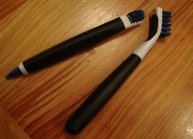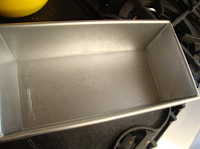Today we needed bread, so it was a good time to try out the larger bread pan, and I decided to use part of the dough for buns, so that I could try out and compare the pastry brushes, also. I had the opportunity to use the OXO cleaning brush set, too, of course, on our grain mill's flour bin, and the crevices of my bread mixer's bowl and dough hook.
 Cleaning Brushes: These simple tools did a fine job. I was able to scrub out the most difficult areas and feel better about the cleanliness of my tools awaiting the next batch of dough. I really liked the larger brush, but like the pointy, flexible tool on the end of the smaller brush.
Cleaning Brushes: These simple tools did a fine job. I was able to scrub out the most difficult areas and feel better about the cleanliness of my tools awaiting the next batch of dough. I really liked the larger brush, but like the pointy, flexible tool on the end of the smaller brush.  Since I need to keep one dry to deal with the flour bin, as anything damp turns the coating of flour into glue, I don't really want to use it in washing the mixer bowl and dough hook. The pointy appendage of the smaller brush is helpful for the tiny dough-collecting spots, but the smaller brush means more work to clean the broader areas. I will need a larger brush, or will end up using a combination of small brush and wash rag to clean the doughy items.
Since I need to keep one dry to deal with the flour bin, as anything damp turns the coating of flour into glue, I don't really want to use it in washing the mixer bowl and dough hook. The pointy appendage of the smaller brush is helpful for the tiny dough-collecting spots, but the smaller brush means more work to clean the broader areas. I will need a larger brush, or will end up using a combination of small brush and wash rag to clean the doughy items.Bread Pan: For the bread, I decided to make one of our usual-sized loaves and one in the larger pan. First I had to determine how much dough to put in each. Since the new one is referred to as a 1-1/2-pound loaf pan, and it's counterpart, sized similarly to those I usually use is labeled as a 1-pound loaf pan, it was easy to figure that I needed 1 1/2 times the dough in the larger pan. So for this maiden outing, I put 41 oz of dough in the new, large pan, while I used about 27 oz of dough in my old pan.
I ended up with very tall loaves in both, so I will have to try this again with smaller amounts to try to get the wider, lower loaves that might be easier to slice.
The other thing I wanted to see, just for sharing my recipe with those who don't have an oven probe that will help judge doneness, is the difference in baking time. After 15 minutes of baking, I placed the probe through the end side into the center of the loaf in the smaller pan, figuring, of course, it would reach 200 degrees first. When the temperature was reached, I put that loaf on a rack to cool, and moved the probe to the larger loaf to see how much longer it needed to reach that same, done temperature.
 I'd set the oven a little lower than usual, at 330 degrees instead of 350, so the larger loaf's exterior wouldn't cook too fast for the heftier interior. The smaller loaf was done (reached 200 degrees) in 37 minutes. At that point the internal temperature of the larger loaf was 160 degrees. In 13 more minutes, it was done, too... So it took 50 minutes to bake.
I'd set the oven a little lower than usual, at 330 degrees instead of 350, so the larger loaf's exterior wouldn't cook too fast for the heftier interior. The smaller loaf was done (reached 200 degrees) in 37 minutes. At that point the internal temperature of the larger loaf was 160 degrees. In 13 more minutes, it was done, too... So it took 50 minutes to bake. |
| After use |
 |
| The 2 bread sizes. Not sure that this new pan is as wide as Hubby was hoping for. |
I wipe out my bread pans with a paper or clean towel after using (no soap or scrubbing unless absolutely necessary), so expect that over time, this pan will darken a bit as some grease bakes onto it, forming its own seasoning and only getting better with age.
Pastry Brushes: Both of my new brushes were better to use than my curled and somewhat stiff Kitchen Aid brush. (I know it's been through the dishwasher and otherwise somewhat abused, so it's probably not it's fault that it's as bad as it is now. I still feel the bristles are too long for the control I'd like, though.)
 I grabbed the OXO Silicone Pastry Brush first. As I said, I was happier with it, compared to the Kitchen Aid. However, it seemed to apply the egg wash in lines, consistent with the width and pattern of the silicone 'bristles,' and I felt I had to kind of push the liquid around the tops of my hamburger buns to get an even and thorough coverage.
I grabbed the OXO Silicone Pastry Brush first. As I said, I was happier with it, compared to the Kitchen Aid. However, it seemed to apply the egg wash in lines, consistent with the width and pattern of the silicone 'bristles,' and I felt I had to kind of push the liquid around the tops of my hamburger buns to get an even and thorough coverage.For the 2nd pan, I used the Ateco 1" Flat Pastry Brush, and was much happier. The egg wash spread smoother, thinner, and easier with this brush than with the silicone. I didn't have to go back over areas I'd already brushed as I had to with the OXO. I'm not crazy about the large "Made in China" sticker that graced its packaging, but the OXO was likely made there, too. (I already through out the package, so can't check.)
The silicone brush is dishwasher and hot-pan safe, while this one is not. Will this last like the silicone? Will it begin to retain odors? Will the bristles someday start shedding onto my food? I can't know any of that right now, and there may be pluses and minuses for each that I'm not thinking of at the moment. It will probably be nice to have both. Today I can only say the Ateco brush performed better for me on this task.

